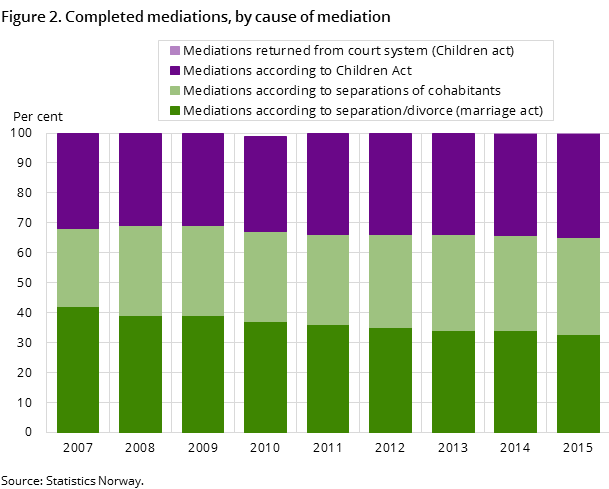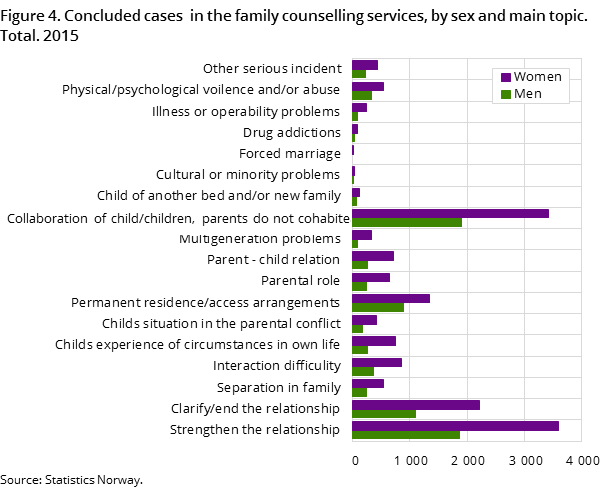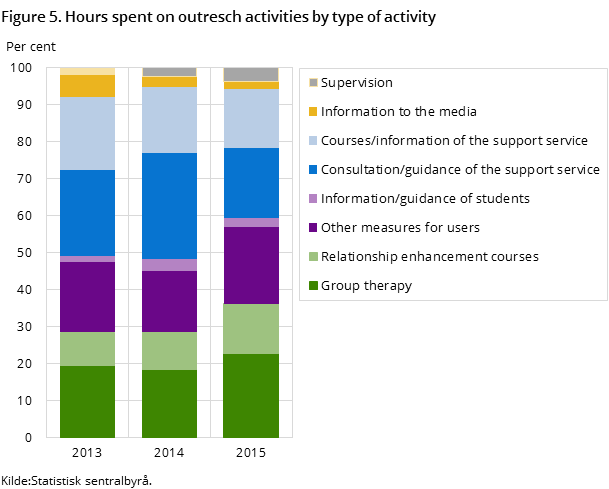Fewer parent mediations, more family counselling cases
Published:
There were just over 20 000 completed parent mediation cases in 2015 – a decline of nearly 4 per cent from the year before. Meanwhile, there were more than 27 000 new family counselling cases, which constitutes a relatively strong increase of 8 per cent.
- Full set of figures
- Family counselling service
- Series archive
- Family counselling service (archive)
The increase in the number of new family counselling cases applies to all regions. The largest percentage increase was for Region South, with 12 per cent. Region North reported most cases per 1 000 inhabitants, with 9.1 cases. As in previous years, Region West had the lowest number of family counselling cases; 5.4 cases per 1 000 inhabitants.
Fewer completed mediations
A total of 20 013 mediations for parents were completed in 2015; a decrease of just under 4 per cent from the previous year. Eighty-two per cent of all mandatory mediations concluded in 2015 were conducted by family offices. This kind of mediation is also conducted by external mediators. The external mediators concluded 18 per cent of the cases in 2015. These percentages are on a par with the previous year. Fifty-eight per cent of all cases were concluded after the one mandatory hour, compared with 60 per cent the year before.
Mediation in connection with separation or divorce accounted for 33 per cent of all mediations, and the breakdown of cohabitation accounted for 32 per cent. Disagreements between parents about parental responsibility, place of residence and access arrangements (mediations under the Children Act) accounted for 35 per cent of the mediations. Few cases are referred back to mediation after they have been referred to the court system; this applied to 54 mediations in 2015.
About half of the mediations conducted by the family counselling offices resulted in written agreements. Children participated in 1 578 mediations in 2015.
More new family counselling cases…
In 2015, there were 27 300 new family counselling cases. This is an increase in nearly 8 per cent from the previous year. In 42 per cent of these cases, issues relating to the parents’ relationship were the main reason for the enquiry. Forty per cent of the primary clients contacted a family counselling office for parental collaboration or guidance. Fourteen per cent of the enquiries were about “Other or complex family problems”, and in 4 per cent of the cases, help for children and adolescents was the reason for enquiry, compared with 5 per cent the previous year.
...but shorter waiting times and duration
For the 27 300 new cases in 2015, the average waiting time per case was 27 days; a decrease of 3 days from the year before. The average treatment time after the first session was 143 days for the 24 600 cases that were closed in 2015, compared with 147 days the previous year.
There was an increase of almost 2 percentage points in the proportion of family counselling cases with a duration of under two months, compared with a reduction of just over 1 percentage point in the proportion of cases with a duration of 6 to 11 months.
The figures for 2015 show that there were more new cases and more closed cases than the year before. The family counselling cases were shorter in terms of number of days. The largest increase was in the number of family counselling cases with a duration of less than 2 months.
More parental guidance – less individual counselling
With regard to the main form of action by the family counselling service, there are minor changes from the year before. Couple counselling still has the greatest share, with 39 per cent of all the 34 679 cases. In 2015, there was an increase from the year before in the share of parents’ counselling, from 25 to 26 per cent of all the cases. The proportion of individual counselling cases was however reduced from 30 to 29 per cent.
There are two types of themes that dominate as the "main subject" of completed family counselling cases in 2015: “To strengthen the relationship” and “Cooperation as regards children where parents do not live together”. These were each the main subject in 22 per cent of the closed cases. In 14 per cent of the cases the main theme was “To clarify/end the relationship”, and 9 per cent related to “Permanent residence/access arrangements”.
In 2015, the family counselling services worked with 80 clinical groups. Separation in the family was the theme for 24 of the groups, and 12 groups had relationship as a theme. However, the theme in group sessions for most groups (38) was violence or abuse.
More man-years to the family counselling service
In 2015, the number of man-years in the family counselling service was 489; a solid increase of 77 man-years from 2014. This increase must be seen in connection with a solid increase in allocations for family counselling in 2015.
The family counselling employees worked on an average of 71 cases each in 2015. This is an average decrease of 8 cases per employee compared to the previous year, indicating that the employees' workload with respect to client cases has decreased.
Some reduction in external activities
Family counselling cases make up just one of the many areas that family counselling offices work with. For example, courses and guidance for students, the support services and the general public also make up a large share of the work. Hours spent on these external activities were just under 14 700 in 2015; a reduction of 4 per cent compared to the year before.
The national child welfare and family counselling service spent almost NOK 433 million on family counselling in 2015; an increase of 17 per cent from the previous year. This increase must also be seen in connection with a solid increase in allocations for family counselling in 2015.
Re-adjustments and break in time series with effect from 2014
Contact
-
Vibeke Sky
-
Unni Beate Grebstad
-
Statistics Norway's Information Centre





